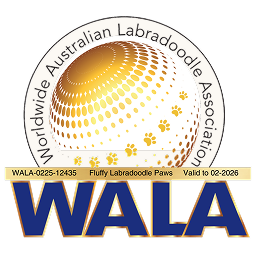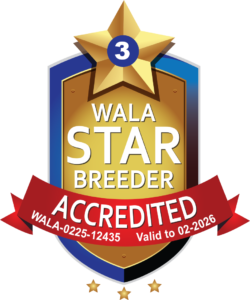Wzorzec rasy Australijski Labradoodle
Labradoodle Socialization

We would like to start by emphasizing that in this article we will present not only the process of socialization, but also all the stages of puppy development and the steps we take so that they grow into confident and stable dogs. Socialization is one of the pillars of our breeding program – through which each puppy gains a solid foundation for a healthy and balanced life by your side.
Prenatal Period (from conception to birth – approximately 63 days)
The prenatal period is an extremely sensitive stage that requires special care for the expectant mother. We provide her with a well-balanced diet and appropriate supplementation tailored to the increasing needs of her body. To ensure her well-being, we avoid stressful situations, as elevated stress levels may negatively impact the development of the puppies. We may create an article dedicated to this topic in the future, but for now, if you’d like to learn more about the negative effects of maternal stress, feel free to check out this material: [Negative Effects of Stress].
During daily walks, we choose familiar and safe routes to minimize unexpected stimuli, while also adjusting the intensity of activity to the mother’s overall condition and comfort. Instead of vigorous exploration, we focus on calm scent-based games, relaxation, and shared moments of affection.
At the same time, we begin logistical preparations for birth – gathering the necessary supplies and thoroughly sanitizing the whelping area to ensure optimal thermal and hygienic conditions for the newborn puppies. Thanks to this comprehensive care, the mother is able to pass on favorable neurohormonal conditions to her offspring, supporting their immunity and emotional balance even before birth.
Prenatal Period (from conception to birth – approximately 63 days)
The neonatal phase is a time of complete dependence on the mother and the environment we create for the puppies. At this stage, they are still blind and deaf, only able to crawl, and they experience the world through smell, warmth, and touch. It is an incredibly sensitive moment that lays the foundation for their future development, which is why our role during this period is especially important.
We ensure warmth, quiet, and a stable environment, avoiding sudden stimuli and noise. Puppies are not yet able to regulate their body temperature, so we provide optimal thermal conditions and carefully monitor their surroundings. All our actions are focused on the mother’s comfort and the litter’s safety.
Starting on the third day of life, we introduce an Early Neurological Stimulation (ENS) program. Between days 3 and 16, the puppies’ nervous system develops at a rapid pace, so appropriate stimulation during this period yields lasting, positive effects. We carry out the exercises once a day, individually with each puppy, for about 3–5 seconds per activity.
The ENS exercises include:
Tactile stimulation – gently stimulating the space between the paw pads using a cotton swab.
Head held upright – holding the puppy with its head pointing vertically upward.
Head pointed downward – holding the puppy with its head facing downward.
Supine position – placing the puppy on its back, with its nose pointing upward.
Thermal stimulation – placing the puppy on a cold, damp towel.
These exercises expose puppies to stimuli they wouldn’t naturally encounter at this stage, activating both the nervous and hormonal systems.
Proven benefits of ENS include:
Improved cardiovascular function
Strengthened circulatory system
Enhanced adrenal gland function
Increased resistance to stress and disease
If you’d like to learn more about Early Neurological Stimulation (ENS), we recommend reading the [COAPE article on ENS].
Transition period (from the 14th to the 21st day of life)
The transitional period is the moment when puppies gradually begin to open up to the outside world, and their development accelerates. It’s a time of spectacular changes – their eyes open, their hearing begins to function, and the little ones become increasingly aware of their surroundings.
The emergence of sight and hearing is a milestone – puppies start responding to light, movement, and their first sounds. They also begin making their first wobbly attempts at walking, though their coordination is still limited. During this time, we also observe the first play between littermates and the appearance of their first teeth.
For us, this is the time to introduce gentle auditory and olfactory stimuli – soft music in the background, household sounds (e.g., the dishwasher, vacuum cleaner on a low setting, voices). We enrich the puppies’ environment with new textures and surfaces – a soft blanket, pads with various textures, and gentle obstacles they can crawl through.
Socialization phase (from 3 to 12 - 14 weeks)
This is one of the most important and intense stages in a puppy’s development. It is during this time that a young dog learns to recognize the world, build relationships with people and other dogs, and develop responses to new situations, sounds, and environments. Everything a puppy experiences at this stage will stay with them for life.
At our kennel, we place great emphasis on this stage. Starting from the 3rd week of life, we systematically introduce environmental stimuli: various surfaces (sensory mats, wood, grass), toys with different textures and shapes, safe obstacles, tunnels, and ramps. These help develop coordination, balance, and self-confidence.
From around the 4th week, puppies begin to explore the space outside their whelping area. We create socialization playgrounds that provide a variety of challenges and encourage independent exploration. At the same time, we gradually expose them to everyday household sounds – the vacuum cleaner, blender, TV, or doorbell – so that they won’t be fearful of them in the future.
From weeks 5 to 6, we introduce touch and coordination exercises: brushing, checking ears, handling paws, and getting used to grooming routines – all done in a calm and positive environment. During this time, we also welcome trusted guests, allowing the puppies to get used to meeting new people.
Based on interviews with future owners, we adapt our approach to address individual needs – to ensure each puppy is well-prepared for their new family. At the same time, we begin teaching self-control: waiting for their turn, giving up a toy, calmly staying in a carrier. We also introduce kennel cage training, potty training, short walks with environmental observation, car rides, and exposure to elevators and escalators – all so nothing in their new homes comes as a surprise.
This stage is all about balancing exposure with comfort – we carefully observe each puppy and adjust our approach to support them without overwhelming them.
What’s next?
After reaching 8 weeks of age, puppies typically move to their new homes. This is the moment when you – the new caregiver – take the lead. We’re still here for you as a source of support, but from now on, you’re the one continuing the socialization process, making the most of the crucial “socialization window,” which lasts approximately until the 12th–14th week of life.
During this time, it’s important to consciously and consistently establish the rules of life with your dog and help them explore their surroundings. What you teach your puppy now will stay with them for life.
- 👉 If you allow your puppy on the couch now – don’t expect them to stop doing it on their own as an adult.
- 👉 If you allow them to bite your hands – don’t expect them to grow out of it by themselves.
- 👉 If you encourage barking now – don’t expect them to stop on their own later.
That’s why it’s essential from the very beginning to reinforce only those behaviors that will be acceptable when the dog is fully grown. Set clear rules, be patient and consistent – and your dog will grow into a wonderful, well-balanced family companion.
This article focuses on socialization from the breeder’s perspective, but don’t worry – soon, you’ll also find a detailed step-by-step guide on our website on how to proceed after bringing your puppy home, so you can make the most of those first, most important weeks 🙂
Contact Us
Are you looking for a loyal, loving companion to become a part of your family? Do you have any questions about Australian Labradoodles or our breeding program?
Feel free to contact us – we’re happy to help!
Reach us through:
- Poland, Łódź
- +48 791 518 070
- labradoodlesbreader@gmail.com


